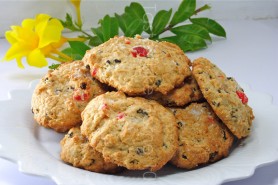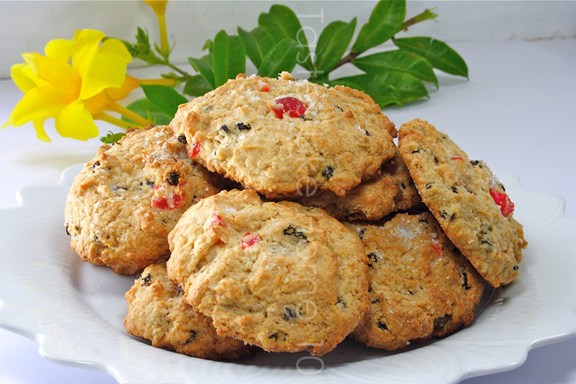Hi Everyone, ovens can seem as if they have minds of their own and for the uninitiated they are downright frightening. It’s too much stress, the newbie bakers say, too many risks, too many memories of failed attempts. These feelings lead to a fear of the oven – oven-phobia, if you will.
 In their minds the oven becomes a dark mysterious interior with unforgiving metal racks, a light that goes on and off at will, a door that shuts you out, not allowing you to peer in, or prod your food as it cooks. Such is the intimidation of an oven for the novice oven-user.
In their minds the oven becomes a dark mysterious interior with unforgiving metal racks, a light that goes on and off at will, a door that shuts you out, not allowing you to peer in, or prod your food as it cooks. Such is the intimidation of an oven for the novice oven-user.
I, on the other hand, love my oven. As I told you a couple of years ago, I rise to bake. Sure, I get a high from cooking, but there is something special about baking. It’s like the oven is this magical place that turns your creations into masterpieces. The skin of the chicken becomes crisp as the meat remains moist, the pastries glisten, the bread rises majestically, the cake swells and browns evenly.
So what’s the secret for freeing you from your oven-phobia and getting you to ultimate success from the oven? The first thing is to know your oven – what type it is, gas or electric, conventional or convection. And the second thing is the recipe! Let’s start with the type of oven.
The Oven
Electric Oven versus Gas Oven – generally speaking the difference is subtle but it can make a difference when it comes to cooking certain foods. Some people argue that heat is distributed more evenly in an electric oven but others counter that argument by testifying that gas ovens give better control of the exact temperature of the oven. And, with the changes in technology, many gas stoves are now able to heat evenly. I have experience using both gas and electric ovens and I have to say that I prefer gas because of the exact oven temperature that it maintains.
Convention Oven versus Convection Oven – the type of ovens most of us have in our homes is the convention oven. The main difference between the two types of oven has to do with the circulation of heat. With a convention oven, the circulation of the heat can be uneven; this unevenness occurs when other pans and pots in the oven block the heat. This is very noticeable when you are using the top and bottom racks in your oven, at the same time. You will often find that recipes that require both racks to be used will suggest that you switch pans on the racks halfway through the cooking time; this is to ensure even cooking. The rack that’s at the top is the one that cooks faster because the heat rises to the top and gets trapped there, hence the need to switch because it blocks the bottom pan from cooking evenly.
 If you’re only using one rack though, you don’t have to worry about this. Most ovens have four (tiers) in which you can move the racks, the default is usually the second tier (from the bottom) but some recipes will tell you to put the rack in the middle which will then be the third tier (from the bottom). The various rack positions is dictated by what it is that you are cooking and the duration of the cooking. Of course if you have a three (tier) oven, it’s a no-brainer.
If you’re only using one rack though, you don’t have to worry about this. Most ovens have four (tiers) in which you can move the racks, the default is usually the second tier (from the bottom) but some recipes will tell you to put the rack in the middle which will then be the third tier (from the bottom). The various rack positions is dictated by what it is that you are cooking and the duration of the cooking. Of course if you have a three (tier) oven, it’s a no-brainer.
A Convection Oven circulates heat evenly and uniformly. This even and uniform heat results in faster cooking at a lower temperature. The even heat circulation ensures that the same temperature reaches the top and bottom of foods as well as foods at all rack levels.
Convection Ovens are much more expensive and are mostly used in professional kitchens such as restaurants, cooking schools etc. Of course those home cooks who can afford it shell out the big bucks for one of them.
The recipe
Let me start by saying this – there are recipes and then there are recipes; a good recipe is supposed to instruct, guide and illuminate, hence the recommendation to read your recipe. Don’t glance at it, don’t scan it, read it and understand it. The key to unlocking the mystery of a baked item lies in careful preparation and the ability to grasp the instructions of a recipe. Once you can you do that you’ll be better able to execute the task.
Oven temperature – preheating your oven to the range specified in the recipe is very important. When you read “preheat the oven” in a recipe it means that the ingredients need to start cooking as soon as they go into the oven. If you don’t preheat you can get a sunken cake that has not risen, chicken that still looks white and raw even though you’ve had it in the oven for an hour and a half as the recipe instructed. As a guide, your oven should be preheated for at least 20 minutes before use.
Prepping baking utensils – before you start mixing your ingredients, prep the pans or dishes they are going to be baked in. A good recipe should instruct you early which size and type of pan or dish to use and also what to line or grease it with. Don’t be one of those people who realise at the last minute, just as they are about to pour the batter into the baking pan, that they have to go scrambling to butter and flour the pan.
Assembling ingredients – assemble your ingredients, measure them as instructed by the recipe and place them in individuals little bowls, cups, or plates, this way, when you are ready to put the ingredients together, everything is at hand. This also prevents you from forgetting to add perhaps that all-important baking powder, salt or spice that is required.
And make sure your ingredients are at the temperature prescribed in the recipe. If it the recipe says the eggs need to be at room temperature, then they need to be at room temperature. Get them out of the fridge early. For those of us living in tropical climates 20 – 30 minutes should be just right.
Baking time – once your pan or dish is in the oven, fight all urges to open the door and peek into the oven. Switch on the oven light if you have to but don’t open the door. If you do, you’d be letting out valuable heat and it can cause, if you’re making a cake for example, to drop. The recipe would have given you an idea of the baking time, or it would suggest a particular doneness (this is actually a word) you should look for. Use the time as a guide and my rule of thumb is this – if the recipe says bake for 10 – 15 minutes, I’d check the results at the 10-minute mark, if it looks and tests done, I remove it from the oven, if not I’d extend it by the time suggested by the recipe, in this case 5 minutes. As you become more relaxed and familiar with baking, you will develop your own intuition about whether you should let it bake for the extra 5 minutes or if 3 minutes is good enough.
Ready to do some baking now? March into that kitchen, stare down your oven, turn it on, get to work mixing and show the oven who’s the boss!
Cynthia
Fruit Rock Buns
Yield: 12
Ingredients
8 ounces all-purpose flour
4 teaspoons baking powder
¼ teaspoon ground cinnamon
¼ teaspoon grated nutmeg
A pinch of salt
4 ounces cold unsalted butter
4 ounces granulated sugar
2 ounces currants
2 ounces cherries, diced
1 egg, room temperature, lightly beaten
½ teaspoon vanilla essence
1 tablespoon whole milk
Equipment
1 large bowl
1 pastry blender or 2 table knives
1 tablespoon
2 baking sheets, lined with parchment paper
Wire racks
Method
1. Preheat oven to 400 degrees F
2. Add flour, baking powder, cinnamon, nutmeg and salt to bowl and mix thoroughly
3. Cut in butter to flour mixture until it resembles coarse crumbs
4. Stir in sugar, raisins and cherries
Add essence and milk to beaten egg and whisk gently
5. Pour egg mixture into dry ingredients and combine and make stiff dough. Do not over mix
6. Using the tablespoon, measure and roughly place mounds of the mixture onto baking sheets with wide spaces between each (6 per baking sheet)
7. Bake for 15 – 20 minutes, switching pans halfway through the baking time
8. Cool on wire racks. Serve warm or at room temperature










